University Nursing: Evidence-Based Practice Assignment Analysis
VerifiedAdded on 2023/01/18
|7
|1496
|69
Homework Assignment
AI Summary
This assignment comprehensively examines evidence-based practice in nursing, addressing key concepts such as the role of EBP, Tanner's model of clinical judgment, and the importance of patient values. It explores barriers and facilitators to EBP implementation, the significance of randomized controlled trials, and the distinction between primary and secondary studies. The assignment delves into a specific research study on total knee replacement, analyzing the study's methodology, variables, and results, including the use of KOOS scores and walk tests. Furthermore, it critically evaluates the study's sample size, potential biases, and the overall effectiveness of the intervention, providing a detailed analysis of the findings and their implications for clinical practice. The assignment also offers insights into the impact of the treatment on patient mobility and quality of life.
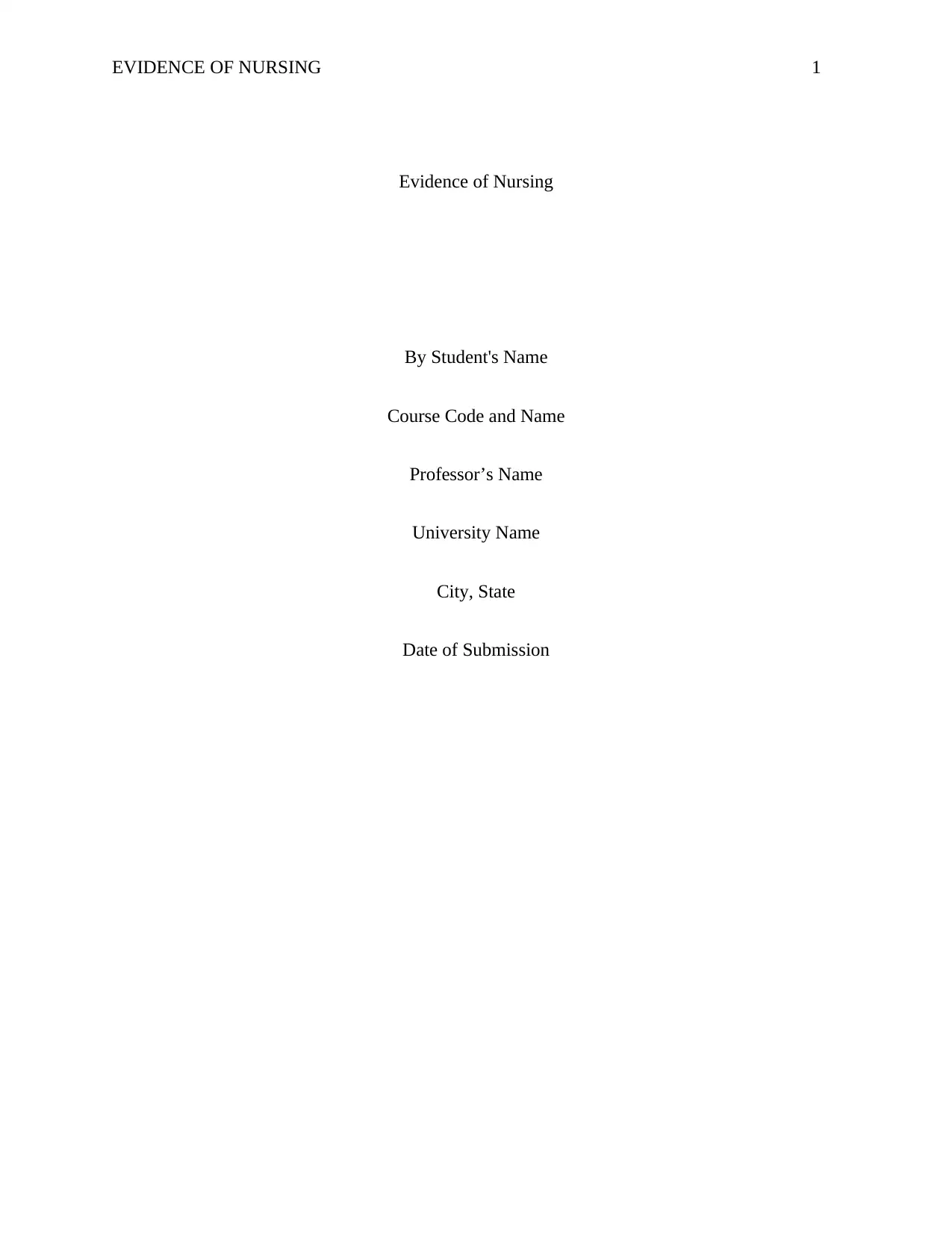
EVIDENCE OF NURSING 1
Evidence of Nursing
By Student's Name
Course Code and Name
Professor’s Name
University Name
City, State
Date of Submission
Evidence of Nursing
By Student's Name
Course Code and Name
Professor’s Name
University Name
City, State
Date of Submission
Paraphrase This Document
Need a fresh take? Get an instant paraphrase of this document with our AI Paraphraser
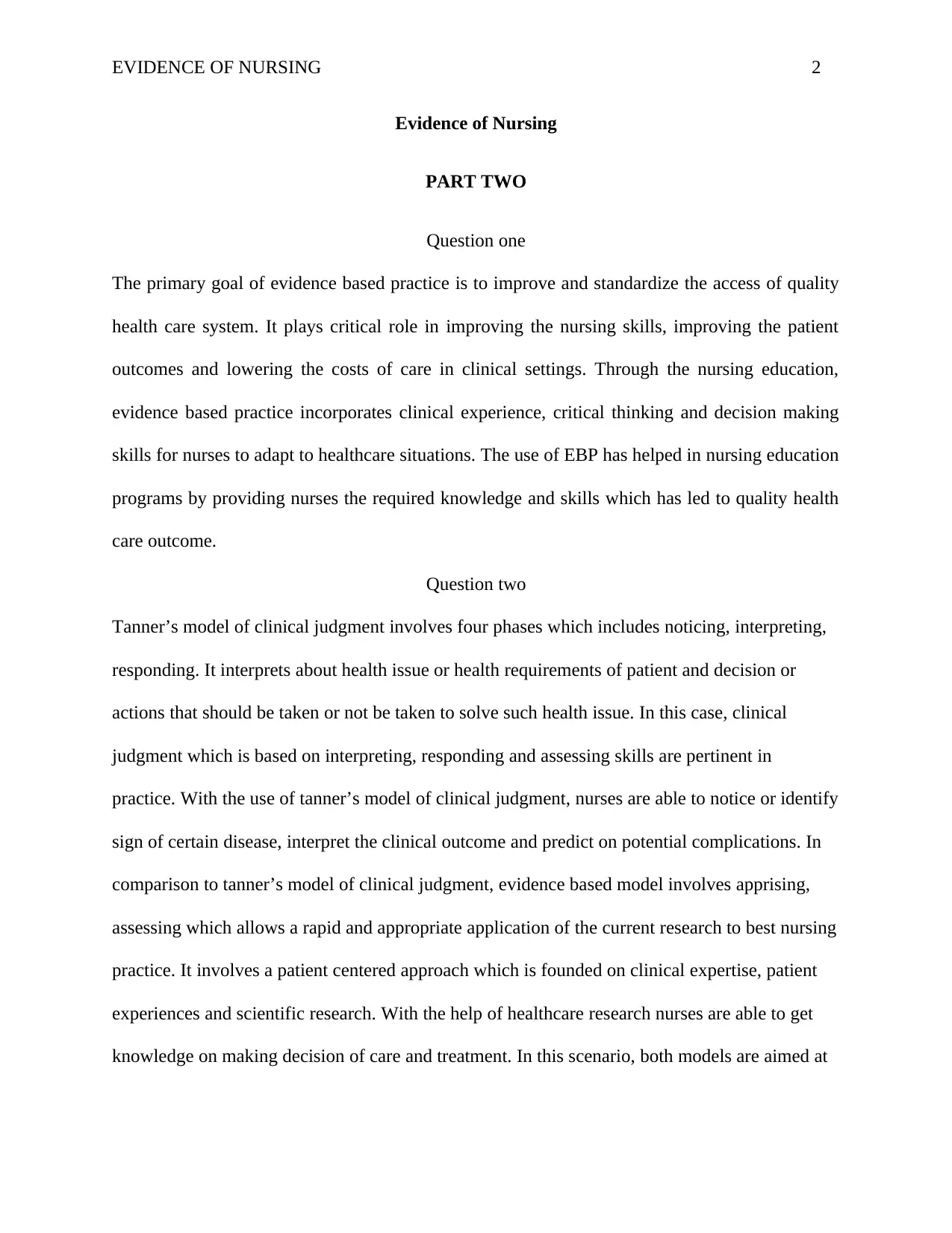
EVIDENCE OF NURSING 2
Evidence of Nursing
PART TWO
Question one
The primary goal of evidence based practice is to improve and standardize the access of quality
health care system. It plays critical role in improving the nursing skills, improving the patient
outcomes and lowering the costs of care in clinical settings. Through the nursing education,
evidence based practice incorporates clinical experience, critical thinking and decision making
skills for nurses to adapt to healthcare situations. The use of EBP has helped in nursing education
programs by providing nurses the required knowledge and skills which has led to quality health
care outcome.
Question two
Tanner’s model of clinical judgment involves four phases which includes noticing, interpreting,
responding. It interprets about health issue or health requirements of patient and decision or
actions that should be taken or not be taken to solve such health issue. In this case, clinical
judgment which is based on interpreting, responding and assessing skills are pertinent in
practice. With the use of tanner’s model of clinical judgment, nurses are able to notice or identify
sign of certain disease, interpret the clinical outcome and predict on potential complications. In
comparison to tanner’s model of clinical judgment, evidence based model involves apprising,
assessing which allows a rapid and appropriate application of the current research to best nursing
practice. It involves a patient centered approach which is founded on clinical expertise, patient
experiences and scientific research. With the help of healthcare research nurses are able to get
knowledge on making decision of care and treatment. In this scenario, both models are aimed at
Evidence of Nursing
PART TWO
Question one
The primary goal of evidence based practice is to improve and standardize the access of quality
health care system. It plays critical role in improving the nursing skills, improving the patient
outcomes and lowering the costs of care in clinical settings. Through the nursing education,
evidence based practice incorporates clinical experience, critical thinking and decision making
skills for nurses to adapt to healthcare situations. The use of EBP has helped in nursing education
programs by providing nurses the required knowledge and skills which has led to quality health
care outcome.
Question two
Tanner’s model of clinical judgment involves four phases which includes noticing, interpreting,
responding. It interprets about health issue or health requirements of patient and decision or
actions that should be taken or not be taken to solve such health issue. In this case, clinical
judgment which is based on interpreting, responding and assessing skills are pertinent in
practice. With the use of tanner’s model of clinical judgment, nurses are able to notice or identify
sign of certain disease, interpret the clinical outcome and predict on potential complications. In
comparison to tanner’s model of clinical judgment, evidence based model involves apprising,
assessing which allows a rapid and appropriate application of the current research to best nursing
practice. It involves a patient centered approach which is founded on clinical expertise, patient
experiences and scientific research. With the help of healthcare research nurses are able to get
knowledge on making decision of care and treatment. In this scenario, both models are aimed at
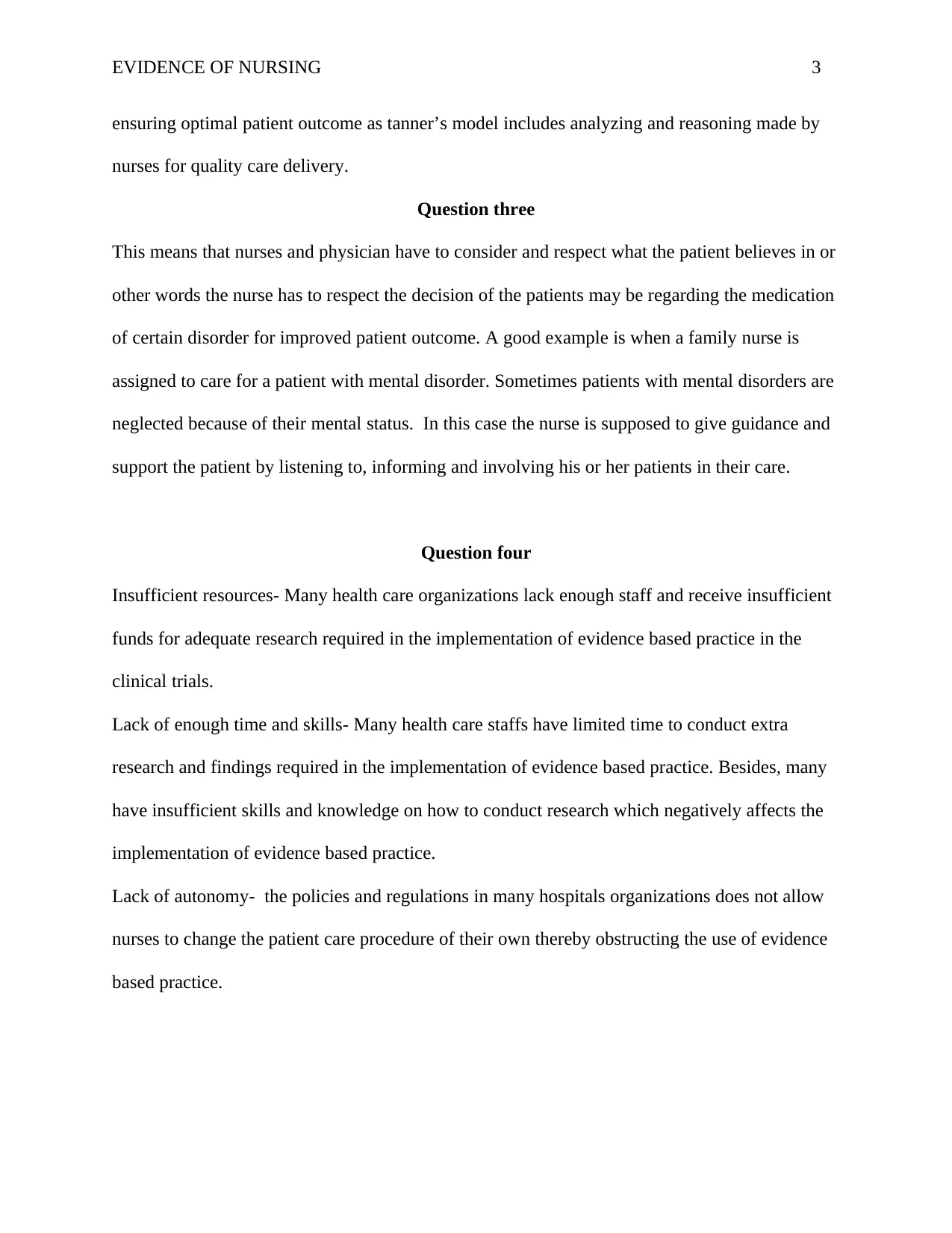
EVIDENCE OF NURSING 3
ensuring optimal patient outcome as tanner’s model includes analyzing and reasoning made by
nurses for quality care delivery.
Question three
This means that nurses and physician have to consider and respect what the patient believes in or
other words the nurse has to respect the decision of the patients may be regarding the medication
of certain disorder for improved patient outcome. A good example is when a family nurse is
assigned to care for a patient with mental disorder. Sometimes patients with mental disorders are
neglected because of their mental status. In this case the nurse is supposed to give guidance and
support the patient by listening to, informing and involving his or her patients in their care.
Question four
Insufficient resources- Many health care organizations lack enough staff and receive insufficient
funds for adequate research required in the implementation of evidence based practice in the
clinical trials.
Lack of enough time and skills- Many health care staffs have limited time to conduct extra
research and findings required in the implementation of evidence based practice. Besides, many
have insufficient skills and knowledge on how to conduct research which negatively affects the
implementation of evidence based practice.
Lack of autonomy- the policies and regulations in many hospitals organizations does not allow
nurses to change the patient care procedure of their own thereby obstructing the use of evidence
based practice.
ensuring optimal patient outcome as tanner’s model includes analyzing and reasoning made by
nurses for quality care delivery.
Question three
This means that nurses and physician have to consider and respect what the patient believes in or
other words the nurse has to respect the decision of the patients may be regarding the medication
of certain disorder for improved patient outcome. A good example is when a family nurse is
assigned to care for a patient with mental disorder. Sometimes patients with mental disorders are
neglected because of their mental status. In this case the nurse is supposed to give guidance and
support the patient by listening to, informing and involving his or her patients in their care.
Question four
Insufficient resources- Many health care organizations lack enough staff and receive insufficient
funds for adequate research required in the implementation of evidence based practice in the
clinical trials.
Lack of enough time and skills- Many health care staffs have limited time to conduct extra
research and findings required in the implementation of evidence based practice. Besides, many
have insufficient skills and knowledge on how to conduct research which negatively affects the
implementation of evidence based practice.
Lack of autonomy- the policies and regulations in many hospitals organizations does not allow
nurses to change the patient care procedure of their own thereby obstructing the use of evidence
based practice.
⊘ This is a preview!⊘
Do you want full access?
Subscribe today to unlock all pages.

Trusted by 1+ million students worldwide
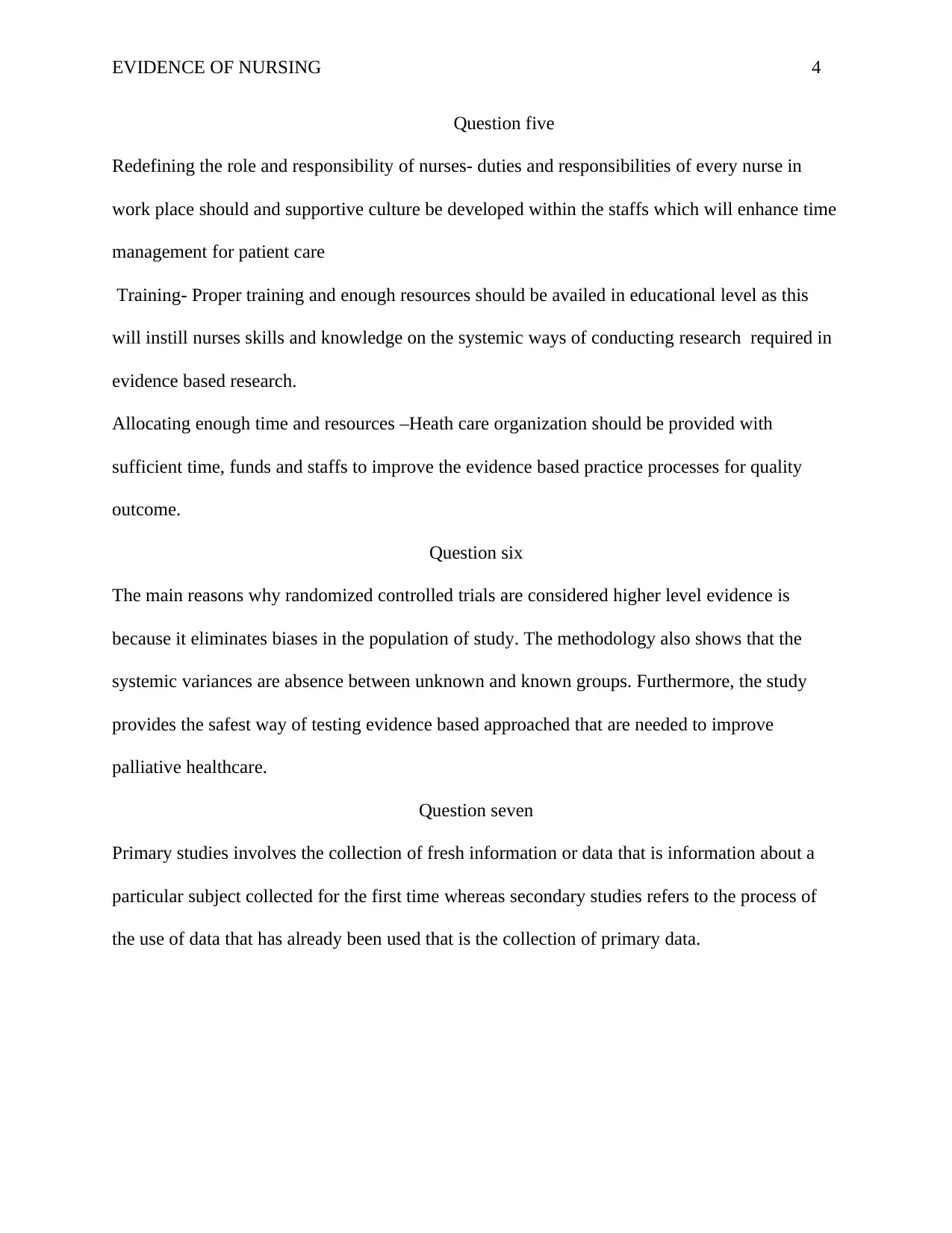
EVIDENCE OF NURSING 4
Question five
Redefining the role and responsibility of nurses- duties and responsibilities of every nurse in
work place should and supportive culture be developed within the staffs which will enhance time
management for patient care
Training- Proper training and enough resources should be availed in educational level as this
will instill nurses skills and knowledge on the systemic ways of conducting research required in
evidence based research.
Allocating enough time and resources –Heath care organization should be provided with
sufficient time, funds and staffs to improve the evidence based practice processes for quality
outcome.
Question six
The main reasons why randomized controlled trials are considered higher level evidence is
because it eliminates biases in the population of study. The methodology also shows that the
systemic variances are absence between unknown and known groups. Furthermore, the study
provides the safest way of testing evidence based approached that are needed to improve
palliative healthcare.
Question seven
Primary studies involves the collection of fresh information or data that is information about a
particular subject collected for the first time whereas secondary studies refers to the process of
the use of data that has already been used that is the collection of primary data.
Question five
Redefining the role and responsibility of nurses- duties and responsibilities of every nurse in
work place should and supportive culture be developed within the staffs which will enhance time
management for patient care
Training- Proper training and enough resources should be availed in educational level as this
will instill nurses skills and knowledge on the systemic ways of conducting research required in
evidence based research.
Allocating enough time and resources –Heath care organization should be provided with
sufficient time, funds and staffs to improve the evidence based practice processes for quality
outcome.
Question six
The main reasons why randomized controlled trials are considered higher level evidence is
because it eliminates biases in the population of study. The methodology also shows that the
systemic variances are absence between unknown and known groups. Furthermore, the study
provides the safest way of testing evidence based approached that are needed to improve
palliative healthcare.
Question seven
Primary studies involves the collection of fresh information or data that is information about a
particular subject collected for the first time whereas secondary studies refers to the process of
the use of data that has already been used that is the collection of primary data.
Paraphrase This Document
Need a fresh take? Get an instant paraphrase of this document with our AI Paraphraser
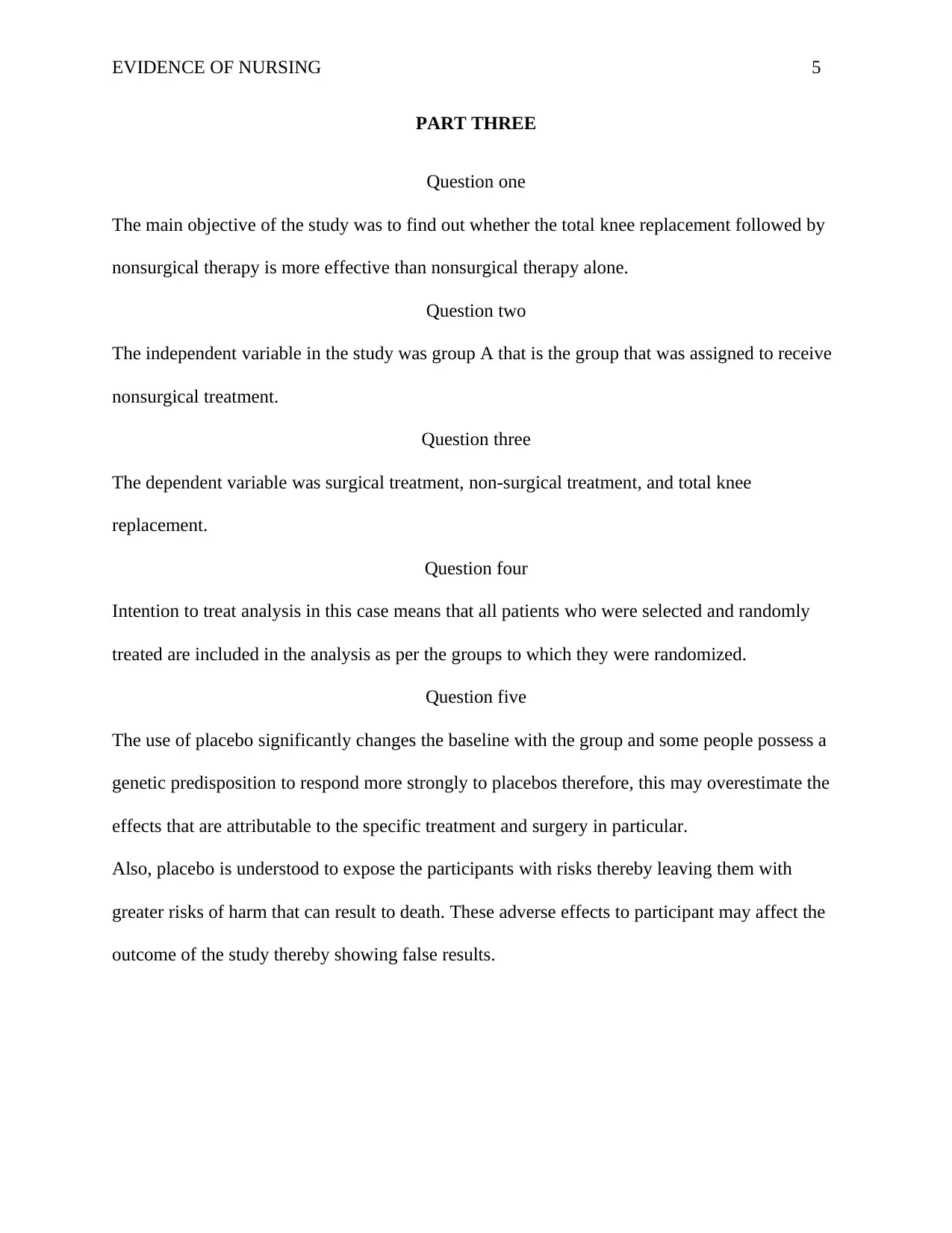
EVIDENCE OF NURSING 5
PART THREE
Question one
The main objective of the study was to find out whether the total knee replacement followed by
nonsurgical therapy is more effective than nonsurgical therapy alone.
Question two
The independent variable in the study was group A that is the group that was assigned to receive
nonsurgical treatment.
Question three
The dependent variable was surgical treatment, non-surgical treatment, and total knee
replacement.
Question four
Intention to treat analysis in this case means that all patients who were selected and randomly
treated are included in the analysis as per the groups to which they were randomized.
Question five
The use of placebo significantly changes the baseline with the group and some people possess a
genetic predisposition to respond more strongly to placebos therefore, this may overestimate the
effects that are attributable to the specific treatment and surgery in particular.
Also, placebo is understood to expose the participants with risks thereby leaving them with
greater risks of harm that can result to death. These adverse effects to participant may affect the
outcome of the study thereby showing false results.
PART THREE
Question one
The main objective of the study was to find out whether the total knee replacement followed by
nonsurgical therapy is more effective than nonsurgical therapy alone.
Question two
The independent variable in the study was group A that is the group that was assigned to receive
nonsurgical treatment.
Question three
The dependent variable was surgical treatment, non-surgical treatment, and total knee
replacement.
Question four
Intention to treat analysis in this case means that all patients who were selected and randomly
treated are included in the analysis as per the groups to which they were randomized.
Question five
The use of placebo significantly changes the baseline with the group and some people possess a
genetic predisposition to respond more strongly to placebos therefore, this may overestimate the
effects that are attributable to the specific treatment and surgery in particular.
Also, placebo is understood to expose the participants with risks thereby leaving them with
greater risks of harm that can result to death. These adverse effects to participant may affect the
outcome of the study thereby showing false results.

EVIDENCE OF NURSING 6
Question six
The blind to group allocations in this study are the authors who were blinded with study groups
labeled A and B in order to reduce the risk of biasness during the interpretation of the results.
Question seven
No, in my opinion the trial did not utilize adequate sample size. This is because there was only a
total of 95 patients and only 2 percent that is one patient who underwent total knee replacement.
The study could have increased the 2 percent for total knee replacement to 10 percent.
Question eight
The results of participant who were divided into different two groups which include total knee
replacement group and non-surgical treatment group may be impacted by the differences of
genetics of each individual. To avoid false results, the dietary was used to minimize these
differences. Therefore the importance of the similar baseline indicates that the known and
unknown factors such as such as genetics, sex, age disease activity and duration of the disease of
every participant will not affect the outcome of the study. Furthermore, this is important as it
adds validity to statistical tests used in the control group thereby generating the randomized
sequences that are significant in the success of the study.
Question nine
KOOS score is a measure that is used to measure pain, symptoms and activities of quality life. Its
score ranges from zero which means (worst) to 100(best). As per the study it indicates there was
an increase in the KOOS score for the group with total knee replacement means that there had
clinical relevant improvement. The results shown in the table indicate that the total knee
Question six
The blind to group allocations in this study are the authors who were blinded with study groups
labeled A and B in order to reduce the risk of biasness during the interpretation of the results.
Question seven
No, in my opinion the trial did not utilize adequate sample size. This is because there was only a
total of 95 patients and only 2 percent that is one patient who underwent total knee replacement.
The study could have increased the 2 percent for total knee replacement to 10 percent.
Question eight
The results of participant who were divided into different two groups which include total knee
replacement group and non-surgical treatment group may be impacted by the differences of
genetics of each individual. To avoid false results, the dietary was used to minimize these
differences. Therefore the importance of the similar baseline indicates that the known and
unknown factors such as such as genetics, sex, age disease activity and duration of the disease of
every participant will not affect the outcome of the study. Furthermore, this is important as it
adds validity to statistical tests used in the control group thereby generating the randomized
sequences that are significant in the success of the study.
Question nine
KOOS score is a measure that is used to measure pain, symptoms and activities of quality life. Its
score ranges from zero which means (worst) to 100(best). As per the study it indicates there was
an increase in the KOOS score for the group with total knee replacement means that there had
clinical relevant improvement. The results shown in the table indicate that the total knee
⊘ This is a preview!⊘
Do you want full access?
Subscribe today to unlock all pages.

Trusted by 1+ million students worldwide
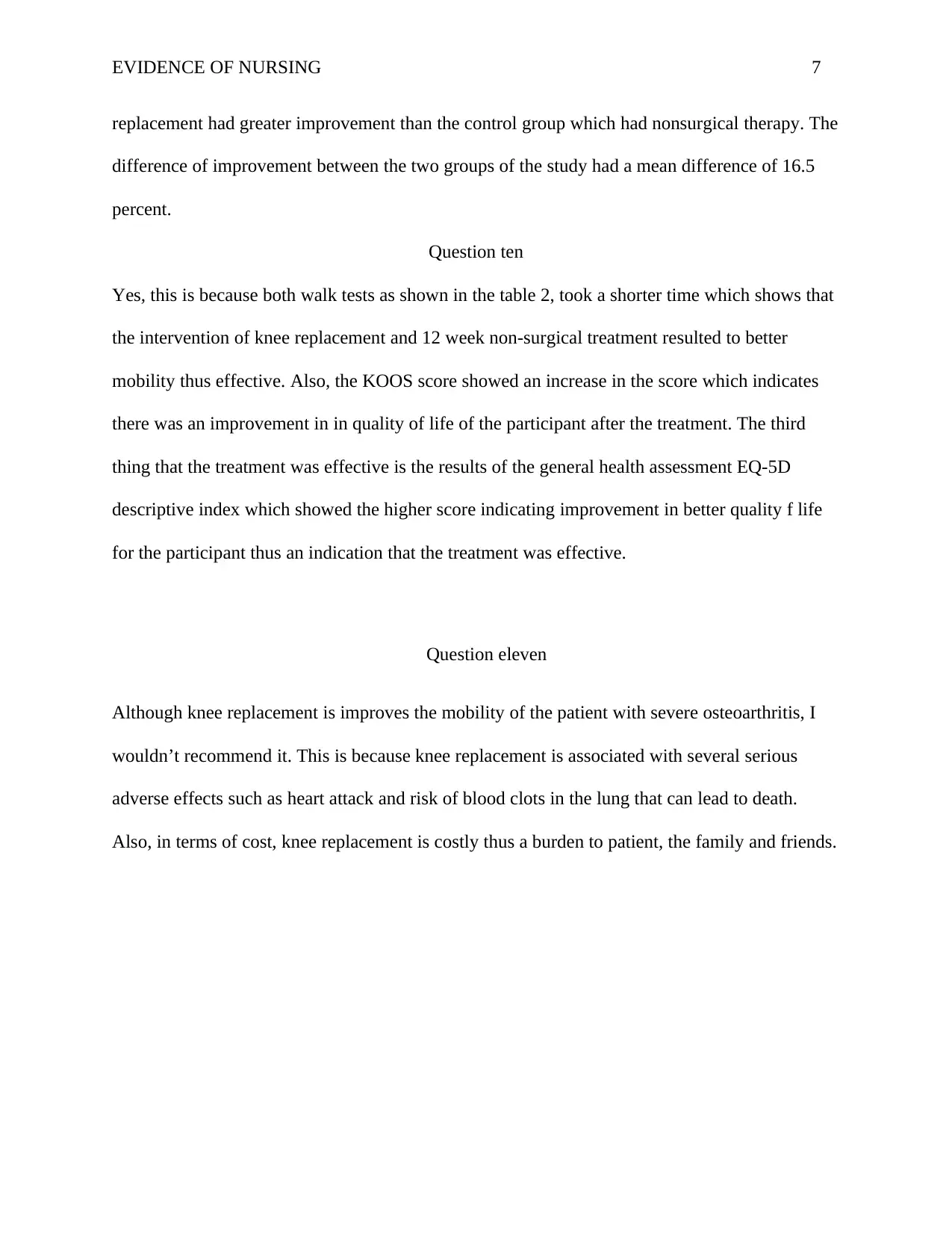
EVIDENCE OF NURSING 7
replacement had greater improvement than the control group which had nonsurgical therapy. The
difference of improvement between the two groups of the study had a mean difference of 16.5
percent.
Question ten
Yes, this is because both walk tests as shown in the table 2, took a shorter time which shows that
the intervention of knee replacement and 12 week non-surgical treatment resulted to better
mobility thus effective. Also, the KOOS score showed an increase in the score which indicates
there was an improvement in in quality of life of the participant after the treatment. The third
thing that the treatment was effective is the results of the general health assessment EQ-5D
descriptive index which showed the higher score indicating improvement in better quality f life
for the participant thus an indication that the treatment was effective.
Question eleven
Although knee replacement is improves the mobility of the patient with severe osteoarthritis, I
wouldn’t recommend it. This is because knee replacement is associated with several serious
adverse effects such as heart attack and risk of blood clots in the lung that can lead to death.
Also, in terms of cost, knee replacement is costly thus a burden to patient, the family and friends.
replacement had greater improvement than the control group which had nonsurgical therapy. The
difference of improvement between the two groups of the study had a mean difference of 16.5
percent.
Question ten
Yes, this is because both walk tests as shown in the table 2, took a shorter time which shows that
the intervention of knee replacement and 12 week non-surgical treatment resulted to better
mobility thus effective. Also, the KOOS score showed an increase in the score which indicates
there was an improvement in in quality of life of the participant after the treatment. The third
thing that the treatment was effective is the results of the general health assessment EQ-5D
descriptive index which showed the higher score indicating improvement in better quality f life
for the participant thus an indication that the treatment was effective.
Question eleven
Although knee replacement is improves the mobility of the patient with severe osteoarthritis, I
wouldn’t recommend it. This is because knee replacement is associated with several serious
adverse effects such as heart attack and risk of blood clots in the lung that can lead to death.
Also, in terms of cost, knee replacement is costly thus a burden to patient, the family and friends.
1 out of 7
Related Documents
Your All-in-One AI-Powered Toolkit for Academic Success.
+13062052269
info@desklib.com
Available 24*7 on WhatsApp / Email
![[object Object]](/_next/static/media/star-bottom.7253800d.svg)
Unlock your academic potential
Copyright © 2020–2025 A2Z Services. All Rights Reserved. Developed and managed by ZUCOL.





